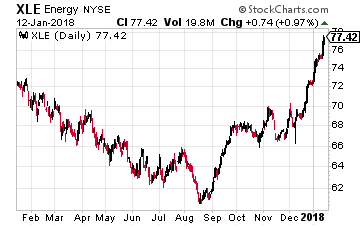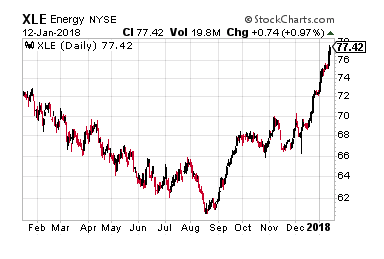Investors often try to figure out themes in the financial markets once a new trading year hits. 2017 was all about low volatility, cryptocurrencies, and tax reform. With tax reform out of the way, we still have low volatility and cryptocurrencies/blockchain tech on the board. What else could be in store?
Obviously, the jury’s still out on what the new trends will be this year – if there are any new ones. So far, conditions have been a lot like 2017. However, I believe we’re going to start hearing and seeing more about inflation.
You see, the economy is already doing well. Add in tax cuts for individuals and businesses, and there’s going to be even more money floating around. That extra money could easily make its way into the consumer/business spending ledger. If enough money is spent on goods and services, we could finally see a ramp up in inflation.
Investors are already showing some concern about inflation, with the move into gold this year. So far, the price of gold is up about 8% since-mid December. It’s the first time since last September that gold is closing in on $1,350 per ounce. Keep in mind, gold is a very common hedge against inflation.
Here’s the thing…
Besides gold, most commodities generally serve as a good inflation hedge. Commodity prices tend to go up as the price of the dollar goes down (a recipe for inflation). Many investors look to precious metals in these scenarios, but energy is also a big beneficiary of inflation hedging.
 Crude oil is already up close to 7% just this year (all two weeks of it). Natural gas is up close to 9%. What’s more, energy stocks are following suit. The Energy Select Sector SPDR ETF(NYSE: XLE) is up over 7% year-to-date.
Crude oil is already up close to 7% just this year (all two weeks of it). Natural gas is up close to 9%. What’s more, energy stocks are following suit. The Energy Select Sector SPDR ETF(NYSE: XLE) is up over 7% year-to-date.
At least one very well-funded trader believes XLE and energy stocks are going to continue their run higher. With XLE trading around $76.50, the trader purchased 27,000 March 77 calls for $1.67. That means the trader will start generating profits above $78.67 at expiration.
This is obviously an extremely bullish trade. The trader is betting $4.5 million that XLE is going to keep going higher. Every $1 XLE rises above the breakeven point will result in $2.7 million in profits.
Now, this is a nice, easy way to make a bullish bet on XLE. However, if you want to save some money, you could also do this trade as a call spread. Using a call spread (selling a higher call against your long call in the same expiration) would substantially reduce costs, but also cap your gains.
For example, at the time this trade was executed, you could have sold the 81 calls for about $0.50. The total cost of the trade would have been reduced to around $1.15. To find max gain potential you just find the width between the long and short strikes ($3) and subtract the price paid ($1.15) and you get $1.85. That’s potential gains of 160%. A call spread like this is an easy way to lower your risk without sacrificing too much in potential upside.
[FREE REPORT] Options Income Blueprint: 3 Proven Strategies to Earn More Cash Today Discover how to grab $577 to $2,175 every 7 days even if you have a small brokerage account or little experience... And it's as simple as using these 3 proven trading strategies for earning extra cash. They’re revealed in my new ebook, Options Income Blueprint: 3 Proven Strategies to Earn Extra Cash Today. You can get it right now absolutely FREE. Click here right now for your free copy and to start pulling in up to $2,175 in extra income every week.
Source: Investors Alley

